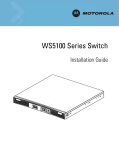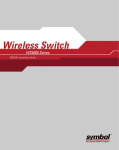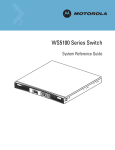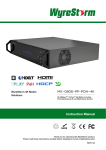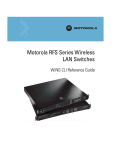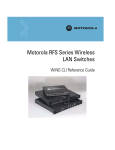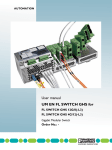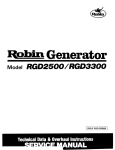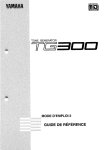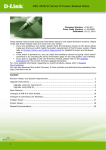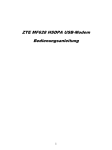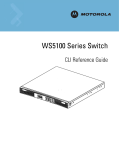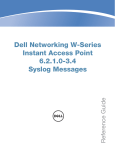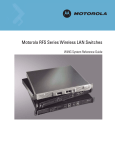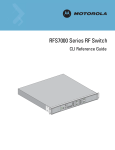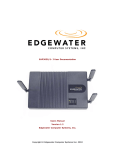Download - Motorola Solutions
Transcript
WS5100 Series Switch
Troubleshooting Guide
Contents
Chapter 1. Overview
Wireless Switch Issues . . . . . . . . . . . . . . . . . . . . . . . . . . . . . . . . . . . . . . . . . . . . . .
Switch Does Not Boot Up. . . . . . . . . . . . . . . . . . . . . . . . . . . . . . . . . . . . . . . . .
Switch Takes a Long Time to Start Up . . . . . . . . . . . . . . . . . . . . . . . . . . . . . . .
Switch Does Not Obtain an IP Address through DHCP . . . . . . . . . . . . . . . . . .
Switch is Stuck in a Booting Loop . . . . . . . . . . . . . . . . . . . . . . . . . . . . . . . . . .
Unable to Connect to the Switch using Telnet or SSH . . . . . . . . . . . . . . . . . .
Web UI is Sluggish, Does Not Refresh Properly, or Does Not Respond . . . . .
Console Port is Not Responding . . . . . . . . . . . . . . . . . . . . . . . . . . . . . . . . . . . .
Shutting Down the Switch . . . . . . . . . . . . . . . . . . . . . . . . . . . . . . . . . . . . . . . .
Shutting Down the Switch using the 1.4.x/2.x Shutdown Command . . .
Shutting Down the Switch using the 3.0 Halt Command . . . . . . . . . . . .
Access Port Issues . . . . . . . . . . . . . . . . . . . . . . . . . . . . . . . . . . . . . . . . . . . . . . . . . .
Access Ports are Not Adopted . . . . . . . . . . . . . . . . . . . . . . . . . . . . . . . . . . . . .
Mobile Unit Issues . . . . . . . . . . . . . . . . . . . . . . . . . . . . . . . . . . . . . . . . . . . . . . . . . .
Access Port Adopted, but MU is Not Being Associated . . . . . . . . . . . . . . . . .
MUs Cannot Associate and/or Authenticate with Access Ports . . . . . . . . . . .
1-2
1-2
1-2
1-2
1-3
1-3
1-4
1-4
1-5
1-5
1-6
1-6
1-6
1-7
1-7
1-8
ii
WS5100 Series Switch Troubleshooting Guide
Poor Voice Quality Issues . . . . . . . . . . . . . . . . . . . . . . . . . . . . . . . . . . . . . . . . . 1-8
Failover Issues . . . . . . . . . . . . . . . . . . . . . . . . . . . . . . . . . . . . . . . . . . . . . . . . . . . . . 1-8
Switch is Not Failing Over . . . . . . . . . . . . . . . . . . . . . . . . . . . . . . . . . . . . . . . . 1-8
Switch is Failing Over Too Frequently . . . . . . . . . . . . . . . . . . . . . . . . . . . . . . . 1-9
Installation Issues. . . . . . . . . . . . . . . . . . . . . . . . . . . . . . . . . . . . . . . . . . . . . . . . . . . 1-9
After Upgrade, Version Number Has Not Changed . . . . . . . . . . . . . . . . . . . . 1-10
Miscellaneous Issues . . . . . . . . . . . . . . . . . . . . . . . . . . . . . . . . . . . . . . . . . . . . . . . 1-10
Excessive Fragmented Data or Excessive Broadcast . . . . . . . . . . . . . . . . . . . 1-10
Excessive Memory Leak . . . . . . . . . . . . . . . . . . . . . . . . . . . . . . . . . . . . . . . . . 1-10
System Logging Mechanism . . . . . . . . . . . . . . . . . . . . . . . . . . . . . . . . . . . . . . . . . 1-11
Chapter 2. LED Information
LED Information . . . . . . . . . . . . . . . . . . . . . . . . . . . . . . . . . . . . . . . . . . . . . . . . . . . .
Start Up: . . . . . . . . . . . . . . . . . . . . . . . . . . . . . . . . . . . . . . . . . . . . . . . . . . . . . .
Primary:. . . . . . . . . . . . . . . . . . . . . . . . . . . . . . . . . . . . . . . . . . . . . . . . . . . . . . .
Standby: . . . . . . . . . . . . . . . . . . . . . . . . . . . . . . . . . . . . . . . . . . . . . . . . . . . . . .
Error Codes: . . . . . . . . . . . . . . . . . . . . . . . . . . . . . . . . . . . . . . . . . . . . . . . . . . .
2-1
2-2
2-2
2-2
2-2
Chapter 3. Network Events & Kern Messages
Network Event Message/Parameter Description Lookup . . . . . . . . . . . . . . . . . . . . 3-1
Network Event Course of Action Lookup . . . . . . . . . . . . . . . . . . . . . . . . . . . . . . . . . 3-7
KERN Messages . . . . . . . . . . . . . . . . . . . . . . . . . . . . . . . . . . . . . . . . . . . . . . . . . . 3-12
Chapter 4. MU Disassociation Codes
802.11 Mobile Unit Disassociation Codes . . . . . . . . . . . . . . . . . . . . . . . . . . . . . . . . 4-1
Chapter 5. Updating the System Image
Upgrading the Switch Image from 1.4.x or 2.x to Version 3.0 . . . . . . . . . . . . . . . . . 5-2
Downgrading the Switch Image from Version 3.0 to 1.4.x or 2.x . . . . . . . . . . . . . . 5-3
Chapter 6. Troubleshooting SNMP Issues
Chapter 7. Security Issues
Switch Password Recovery . . . . . . . . . . . . . . . . . . . . . . . . . . . . . . . . . . . . . . . . . . . 7-2
RADIUS Troubleshooting . . . . . . . . . . . . . . . . . . . . . . . . . . . . . . . . . . . . . . . . . . . . . 7-2
iii
Troubleshooting RADIUS Accounting Issues. . . . . . . . . . . . . . . . . . . . . . . . . . . 7-4
Rogue AP Detection Troubleshooting. . . . . . . . . . . . . . . . . . . . . . . . . . . . . . . . . . . . 7-4
Troubleshooting Firewall Configuration Issues . . . . . . . . . . . . . . . . . . . . . . . . . . . . . 7-5
iv
WS5100 Series Switch Troubleshooting Guide
About This Guide
Introduction
This guide provides information for troubleshooting issues on the WS5100 Series Switch.
NOTE
Screens and windows pictured in this guide are samples and can differ from actual screens.
Documentation Set
The documentation set for the WS5100 Series Switch is partitioned into the following guides to provide information for specific user
needs.
•
WS5100 System Reference- describes WS5100 Series Switch Web UI configuration activities and the resulting network
behavior.
•
WS5100 Installation Guide - describes the basic setup and configuration required to transition to more advanced
configuration of the switch.
•
WS5100 CLI/MIB Reference - describes the Command Line Interface (CLI) and Management Information Base (MIB)
commands used to configure the WS5100 Series Switch.
•
WS5100 Migration Guide - provides upgrade instructions and new feature descriptions for legacy users of the WS5100 Series
Switch.
Document Conventions
The following conventions are used in this document to draw your attention to important information:
NOTE
!
Indicate tips or special requirements.
CAUTION Indicates conditions that can cause equipment damage or data loss.
viii
WS5100 Series Switch Troubleshooting Guide
WARNING! Indicates a condition or procedure that could result in personal injury or equipment damage.
Notational Conventions
The following additional notational conventions are used in this document:
•
Italics are used to highlight the following:
- Chapters and sections in this and related documents
- Dialog box, window and screen names
- Drop-down list and list box names
- Check box and radio button names
- Icons on a screen.
•
GUI text is used to highlight the following:
- Screen names
- Menu items
- Button names on a screen.
•
bullets (•) indicate:
- Action items
- Lists of alternatives
- Lists of required steps that are not necessarily sequential
•
Sequential lists (e.g., those that describe step-by-step procedures) appear as numbered lists.
Overview
This chapter describes common system issues and what to look for while diagnosing the cause of a problem.
Wherever possible, it includes possible suggestions or solutions to resolve the issues.
The following sections are included:
•
Wireless Switch Issues
•
Access Port Issues
•
Mobile Unit Issues
•
Failover Issues
•
Installation Issues
•
Miscellaneous Issues
•
System Logging Mechanism
1-2
Overview
1.1 Wireless Switch Issues
This section describes various issues that may occur when working with the WS5100 Series Switch. Possible
issues include
•
Switch Does Not Boot Up
•
Switch Takes a Long Time to Start Up
•
Switch Does Not Obtain an IP Address through DHCP
•
Switch is Stuck in a Booting Loop
•
Unable to Connect to the Switch using Telnet or SSH
•
Web UI is Sluggish, Does Not Refresh Properly, or Does Not Respond
•
Console Port is Not Responding
•
Shutting Down the Switch
1.1.1 Switch Does Not Boot Up
The WS5100 Series Switch does not boot up to a username prompt via CLI console or Telnet.
Table 1.1 provides suggestions to troubleshoot this issue.
Table 1.1 Switch Does Not Boot Up Troubleshooting Notes
Possible Problem
Suggestions to Correct
Switch has no power
• Verify power cables, fuses, UPS power. The front panel LED lights up when
power is applied to the switch.
• Verify the power switch on the back of the switch is in the I (on) position.
• Have a qualified electrician check the power source to which the switch is
connected.
Chassis fans and/or CPU
fan not rotating
• Visually inspect the fans located inside the switch chassis.
• If one or more of the CPU fans are not running, contact the Symbol Support
center for further instructions.
All else...
Contact Symbol Support.
1.1.2 Switch Takes a Long Time to Start Up
Until DHCP is enabled (and if static IP addresses are not being used), startup can be extremely slow. This is
normal.
1.1.3 Switch Does Not Obtain an IP Address through DHCP
The WS5100 Series Switch requires a routable IP address for the administrator to manage it via Telnet, SSH
or a Web browser. By default, the switch boots up with a non-routable static IP address.
Overview
1-3
Table 1.2 provides suggestions to troubleshoot this issue.
Table 1.2 Switch Does Not Obtain an IP Address through DHCP Troubleshooting Notes
Possible Issue
Suggestions to Correct
DHCP is not configured, or
not available on same
network as the WS5100
Series Switch
• Verify that the configuration for the switch has DHCP enabled. By default, Ethernet
NIC 2 is DHCP enabled. Otherwise, refer to the CLI reference for instructions on
enabling the Ethernet interfaces.
• Ensure that the WS5100 is on the same network as the DHCP server and verify the
server is providing DHCP services.
• Connect another host configured for DHCP and verify it is getting a DHCP address
DHCP is not enabled on
NIC 2 (that is, the Ethernet
port that is not managing
the RF network)
• Enable DHCP, use the CLI command or the GUI to enable DHCP on the Ethernet port
connected to your network.
• Verify that DHCP packets are being sent to NIC 2 using a sniffer tool
• If DHCP packets are seen, check to ensure that the switch is not configured for a
static IP on NIC 2.
All else..
Contact Symbol Support.
1.1.4 Switch is Stuck in a Booting Loop
The WS5100 Series Switch continuously boots and does not change context to a user name prompt.
Table 1.3 provides suggestions to troubleshoot this issue.
Table 1.3 Switch is Stuck in a Booting Loop Troubleshooting Notes
Possible Issue
Suggestions to Correct
Bad flash memory module
Remove the flash memory and install it in a different switch.
Switch not getting enough
ventilation
Verify that the CPU fan is operating properly.
All else...
Contact Symbol Support.
1.1.5 Unable to Connect to the Switch using Telnet or SSH
The WS5100 Series Switch is physically connected to the network, but connecting to the switch using SSH or
Telnet does not work.
Table 1.4 provides suggestions to troubleshoot this issue.
Table 1.4 Unable to Connect to the Switch using Telnet or SSH Troubleshooting Notes
Possible Issue
Suggestions to Correct
Console is not on network
• Check all cabling and terminal emulation program settings to be sure they are
correctly set. See Console Port is Not Responding issue, or the WS5100 Series
Wireless Switch System Reference Guide for more details.
• From a another system on the same network. attempt to ping the switch.
Telnet is not enabled
and/or SSH is disabled
Verify that Telnet or SSH are enabled by using the CLI or GUI (By default, telnet is
disabled.).
1-4
Overview
Table 1.4 Unable to Connect to the Switch using Telnet or SSH Troubleshooting Notes (Continued)
Possible Issue
Suggestions to Correct
Max sessions have been
reached
Maximum allowed sessions is 8 concurrent users connected to a switch. Verify that the
threshold has not been reached. .
Primary LAN is not
receiving Telnet traffic
Verify that Telnet traffic is on the primary VLAN.
All else...
Contact Symbol Support.
1.1.6 Web UI is Sluggish, Does Not Refresh Properly, or Does Not Respond
When configuring the switch, it is easy to overlook the fact that the host computer is running the browser while
the WS5100 Series Switch is providing the data to the browser. Occasionally, while using the Web UI (GUI) the
switch does not respond or appears to be running very slow; this could be a symptom of the host computer or
the network, and not the switch itself. Table 1.5 provides suggestions to troubleshoot this issue.
Table 1.5 Web UI is Sluggish, Does Not Refresh Properly, or Does Not Respond Troubleshooting Notes
Possible Issue
Suggestions to Correct
Bad connection between
switch and console system
Verify the line between the switch and the host computer is functioning normally.
Slow transmission of data
packets
Verify the data packets are being sent to and from the switch using a sniffer tool.
Access ports may try to
adopt while country code is
not set
Set the country name for the switch, which is set to “none” by default.
Packet storm
Check Syslog for any type of a packet storm.
Overburdened with a large
number of access ports
With large numbers of access ports, changing the configuration quickly may cause the
switch to not refresh properly, at least immediately following configuration.
Java JRE is out of date
Be sure you are using Sun Java JRE 1.5 or later. To download the appropriate for your
system go to: http://www.sun.com/java/
All else...
Contact Symbol Support.
1.1.7 Console Port is Not Responding
The WS5100 Series Switch console port is physically connected to the host computer’s serial port, but pressing
the [Enter] key gets no response from the switch.
Table 1.6 provides suggestions to troubleshoot this issue.
Table 1.6 Console Port is Not Responding Troubleshooting Notes
Possible Issue
Suggestions to Correct
Cabling issue
Ensure that a NULL-modem cable is connected from the WS5100 console port to the
host computer’s serial port.
Overview
1-5
Table 1.6 Console Port is Not Responding Troubleshooting Notes (Continued)
Possible Issue
Suggestions to Correct
Not using a terminal
emulation program
Verify a serial terminal emulation program, such as HyperTerminal, is in use.
Settings in terminal
emulation program are
incorrectly set
Check the serial port settings in the serial terminal emulation program being used. The
correct settings are:
All else...
Terminal Type
VT-100
Port
COM 1-4
Terminal Settings
19200 bps transfer rate
8 data bits
no parity
1 stop bit
no flow control
Contact Symbol Support.
1.1.8 Shutting Down the Switch
The CLI commands used to shutdown the switch have changed with the release of the 3.0 version WS5100
Series Switch. Please refer to the following to differentiate between the shutdown command
(1.4.x and 2.x) from the halt command (3.0).
1.1.8.1 Shutting Down the Switch using the 1.4.x/2.x Shutdown Command
To gracefully shutdown the WS5100 Series Switch, issue the shutdown command from the configure
context in the CLI:
WS5000.(Cfg)> shutdown
This command will halt the system.
A manual power cycle will be required to re-start the switch.
Do you want to proceed (yes/no) : yes
System shut down might take a few mins....
Shutting down the switch...
Shutting down dhcp daemon.. done
Shutting down apache server in the OPEN mode...done.
Shutting down cell controller........ done
Shutting down snmpd agent...done.
Shutting down Postgres....done.
INIT: Sending processes the TERM signal
Hostname: WS5000.symbol.com.
Shutting down PacketSwitch interface .....
Shutting down dhcp daemon.. done
Shutting down apache server in the OPEN mode...done.
Cell controller not running.
i2c-core: Device or resource busy
Shutting down Postgres....done.
Stopping periodic command scheduler: cron.
1-6
Overview
Stopping internet superserver: inetd.
Saving random seed... done.
Stopping deferred execution scheduler: atd.
Stopping kernel log daemon: klogd.
Stopping system log daemon: syslogd.
flushing ide devices: hda
System halted.
As directed, wait 10 seconds and turn off the device by toggling the power switch.
1.1.8.2 Shutting Down the Switch using the 3.0 Halt Command
To shut down the WS5100 Series Switch from the CLI, issue a halt command, as the halt command is now
used to shut down the WS5100 Series Switch with the release of the 3.0 version WS5100 baseline:
WS5100#halt
Wireless switch will be halted, do you want to continue? (y/n):y
The system is going down NOW !!
% Connection is closed by administrator!
WIOS_SECURITYMGR[395]: DNSALG: Shutting down.
WIOS_SECURITYMGR[395]: FTPALG: Shutting down.
The system is halted.
NOTE
The WS5100 will power off after issuing a halt command through a
software toggle of the power supply. Be sure to flip the power switch to
the Off position. If the power cord is removed and reinstalled, or power is
lost and restored, the switch will power back on.
1.2 Access Port Issues
This section describes various issues related to access ports within the WS5100 Series Switch network.
1.2.1 Access Ports are Not Adopted
Access ports are not being adopted. Table 1.7 provides suggestions to troubleshoot this issue.
Table 1.7 Access Ports are Not Adopted Troubleshooting Notes
Possible Issue
Suggestions to Correct
Access port is not
configured
Verify the license key that is set in the switch.
Country code for switch is
not set
Verify the country code is entered into the switch prior to adopting any access ports. The
switch is not fully functional until a country code is set.
Access ports are offnetwork
Verify the access ports are connected to the network and powered on.
Switch is configured as
Standby switch
Verify the switch is not configured as a Standby system prior to adopting any access
ports. Even if a Standby switch is not in use, the Primary switch must be in an active
state in order for it to adopt access ports.
The state is automatically determined by the failover system. From the CLI or Web UI
check the standby state to see if the switch is either Primary or Standby
Overview
1-7
Table 1.7 Access Ports are Not Adopted Troubleshooting Notes (Continued)
Possible Issue
Suggestions to Correct
Access ports are restricted
in configuration
Verify the switch is not configured with an access control list that does not allow access
port adoption; verify that access port adoption is not set to “deny”.
Ensure that the access port adoption policy is added with a WLAN.
Access Port is on Exclude
List
Verify the WS5100 Series Switch ACL adoption list does not include the access ports
that are not being adopted.
Miscellaneous other issues
• Check the access port LEDs for “Loadme” message on start-up.
• With a packet sniffer, look for 8375 (broadcast) packets
• Reset the WS5100 Series Switch. If the switch is hung, it may begin to adopt access
ports properly once it has been reset.
All else...
Contact Symbol Support.
1.3 Mobile Unit Issues
This section describes various issues that may occur when working with the Mobile Units associated with the
wireless switch or associated Access Ports. Possible issues include:
•
Access Port Adopted, but MU is Not Being Associated
•
MUs Cannot Associate and/or Authenticate with Access Ports
•
Poor Voice Quality Issues
1.3.1 Access Port Adopted, but MU is Not Being Associated
Access port associated with an MU is not yet being adopted. Table 1.8 provides suggestions to troubleshoot
this issue.
Table 1.8 Access Port Adopted, but MU is Not Being Associated Troubleshooting Notes
Possible Issue
Suggestions to Correct
Unadopted access port
Verify that the switch has adopted the access port with which the MU is trying to
associate.
Incorrect ESSID applied to
the MU
Verify on the MU that the correct ESSID has been applied to the MU.
Ethernet port configuration
issues
• Verify that the Ethernet port connected to thenetwork and has a valid configuration.
• If DHCP is used, verify that the Ethernet cable is connected to the same NIC upon
which DHCP services are enabled.
Incorrect security settings
Verify that the correct security settings are applied to a WLAN in which the MU is tryng
to associate.
All else...
Contact Symbol Support.
1-8
Overview
1.3.2 MUs Cannot Associate and/or Authenticate with Access Ports
MUs cannot associate and/or authenticate with access ports. Table 1.9 provides suggestions to troubleshoot
this issue.
Table 1.9 MUs Cannot Associate and/or Authenticate with Access Ports Troubleshooting Notes
Possible Issue
Suggestions to Correct
Preamble differences
Verify that the Preamble matches between switch and MUs. Try a different setting.
Device key issues
Verify in Syslog that there is not a high rate of decryption error messages. This could
indicate that a device key is incorrect.
MU is not in Adopt List
Verify the device is not in the “do not adopt ACL”.
Keyguard not set on client
Verify Keyguard is set on the client if the Security/WLAN Policy calls for Keygaurd.
1.3.3 Poor Voice Quality Issues
VOIP MUs, BroadCast MultiCast and SpectraLink phones have poor voice quality issues. Table 1.10 provides
suggestions to troubleshoot this issue.
Table 1.10 Poor Voice Quality Issues Troubleshooting Notes
Possible Issue
Suggestions to Correct
Traffic congestion with data
traffic
• Maintain voice and data traffic on separate WLANs.
• Use a QoS Classifier to provide dedicated bandwidth if data and voice traffic are
running on the same WLAN.
Long preamble not used on
Spectralink phones
Verify that a long preamble is used with Spectralink phones.
1.4 Failover Issues
This section describes various issues related to the failover capabilitie of the WS5100 Series Switch. Possible
issues include:
•
Switch is Not Failing Over
•
Switch is Failing Over Too Frequently
1.4.1 Switch is Not Failing Over
Switch is not failing over (Hot Standby) as appropriate.
Table 1.11 provides suggestions to troubleshoot this issue.
Table 1.11 Switch is Not Failing Over Troubleshooting Notes
Possible Issues
Suggestions to Correct
Primary and Standby
switches are not both
enabled
Verify the Primary and Secondary switches are Standby enabled and have the correct
MAC address configured for the correct Primary/Secondary switch.
Overview
1-9
Table 1.11 Switch is Not Failing Over Troubleshooting Notes (Continued)
Possible Issues
Suggestions to Correct
Primary and Standby
switches have mismatched
software versions
Mismatch configurations are not allowed. Verify that the Primary and Secondary
switches have the same software versions running.
Primary and Standby
switches cannot
communicate with each
other
Verify that the Primary and Secondary switch are configured properly and attempt to
ping each switch (using the ping command) from each switch.
Other problems, as listed in
switch logs
Review the local logs on the Standby switch.
MAC address configuration
issues
Review the Syslog. The correct MAC address should be seen when checking the Syslog
heartbeat messages.
Conflicting addressing on
same network
If more than one Primary switch exists on the same network, then use MAC addresses
to configure.
All else...
Contact Symbol Support.
1.4.2 Switch is Failing Over Too Frequently
Switch failing over too frequently (flapping).
Table 1.12 provides suggestions to troubleshoot this issue.
Table 1.12 Switch is Failing Over Too Frequently Troubleshooting Notes
Possible Issues
Suggestions to Correct
One of the switches is
crashing
Check the CPU usage using the CLI or Web UI Diagnostics information.
All else...
Contact Symbol Support.
1.5 Installation Issues
Upgrading and downgrading the WS5100 Series Switch is possible only on the WS5100 platform. Before
upgrading or downgrading any system, save a copy of the system configuration to an FTP or TFTP server.
1-10
Overview
1.5.1 After Upgrade, Version Number Has Not Changed
After upgrading the version number has not changed. Table 1.13 provides suggestions to troubleshoot this
issue.
Table 1.13 After Upgrade, Version Number Has Not Changed Troubleshooting Notes
Possible Issues
Suggestions to Correct
Improper upgrade process
• Refer to the release notes and repeat the upgrade process exactly as stated in the
release notes.
• Verify that the Syslog folder contents from the CLI Service Mode context. Repeat the
upgrade process if necessary.
All else...
Contact Symbol Support.
1.6 Miscellaneous Issues
This section describes various miscellaneous issues related to the WS5100 Series Switch, and that don’t fall
into any of the previously called out issue categories. Possible issues include:
•
Excessive Fragmented Data or Excessive Broadcast
•
Excessive Memory Leak
1.6.1 Excessive Fragmented Data or Excessive Broadcast
Excessive fragmented data or excessive broadcast.
Table 1.14 provides suggestions to troubleshoot this issue.
Table 1.14 Excessive Fragmented Data or Excessive Broadcast Troubleshooting Notes
Possible Issues
Suggestions to Correct
Fragmentation
• Change the MTU size to avoid fragmentation on other ethernet devices.
• Do not allow VoIP traffic when operating on a flat network (no routers or smart
switches).
• Move to a trunked Ethernet port.
• Move to a different configuration.
All else...
Contact Symbol Support.
1.6.2 Excessive Memory Leak
Excessive memory leak. Table 1.15 provides suggestions to troubleshoot this issue.
Table 1.15 Excessive Memory Leak Troubleshooting Notes
Possible Issues
Suggestions to Correct
Memory leak
Using the CLI or Web UI’s Diagnostics section to check the available virtual memory. If
any one process displays an excessive amount of memory usage, that process could be
one of the possible causes of the problem.
Overview
1-11
Table 1.15 Excessive Memory Leak Troubleshooting Notes (Continued)
Possible Issues
Suggestions to Correct
Too many concurrent Telnet
or SSH sessions
Keep the maximum number of Telnet or SSH sessions low (6 or less), even though up to
8 sessions are allowed.
All else...
Contact Symbol Support.
1.7 System Logging Mechanism
The WS5100 Series Switch provides subsystem logging to aSyslog server. There are two Syslog systems, local
and remote. Local Syslog records system information locally, on the switch. The remote Syslog sends
messages to a remote host. All Syslog messages conform to the RFC 3164 message format.
1-12
Overview
LED Information
2.1 LED Information
The WS5100 has two vertically-stacked LEDs on its front panel. The LEDs display three colors (blue,amber, and
red), and three lit states (solid, blinking, and off). The following tables decode the combinations of LED colors
and states.
2-2
Service Mode CLI
2.1.1 Start Up:
Event
Top LED
Bottom LED
Power off
Off
Off
Power On Self Test (POST) running
All colors in rotation
All colors in rotation
POST succeeded
Blue solid
Blue solid
2.1.2 Primary:
Event
Top LED
Bottom LED
Active (Continually Adopting Access Ports)
Blue blinking
Blue solid
No License to Adopt
Amber blinking
Amber blinking
2.1.3 Standby:
Event
Top LED
Bottom LED
Active (Failed Over and Adopting Ports)
Blue blinking
Blue blinking
Active (Not Failed Over)
Blue blinking
Amber solid
2.1.4 Error Codes:
Event
Top LED
Bottom LED
POST failed (critical error)
Red blinking
Red blinking
Software initialization failed
Amber solid
Off
Country code not configured.
Note: During first time setup, the LEDs will
remain in this state until the country code is
configured.
Amber solid
Amber blinking
No access ports have been adopted
Blue blinking
Amber blinking
Network Events & Kern Messages
This chapter includes two network event tables to provide detailed information and understanding of the
WS5100 Series Switch network events that can occur. These tables are:
•
Table 3.1 , Network Event Message/Parameter Description Lookup
•
Table 3.2 , Network Event Course of Action Lookup on page 3-7
3.1 Network Event Message/Parameter Description Lookup
ID
Event
Message
Parameters
0
License number
change
Changed license level from <XX> license
number access ports to <YY> number
access ports.
XX = previous license number (an integer)
YY = new license number (an integer)
1
Clock change
The Wireless Switch clock was changed
<XX>/ <YY> seconds.
XX = + or YY = offset in seconds (an integer)
3-2
Network Events
3.1 Network Event Message/Parameter Description Lookup
ID
Event
Message
Parameters
2
Packet discard
[wrong NIC]
Discarded Packet: Wrong NIC <XX> <XX> vs
<YY> from access port ZZ.
XX = Ethernet port that received the packet
= 1 or 2
YY = Ethernet Port that the access port was
adopted from = 1 or 2
ZZ = MAC (xx:xx:xx:xx:xx:xx) address of the
Access Port
3
Packet discard
[wrong VLAN]
Discarded Packet: Wrong VLAN <XX> <XX>
vs <YY> from access port <ZZ>.
XX = VLAN that received the packet (an
integer).
YY = VLAN the access port was adopted
from (an integer).
ZZ = MAC (xx:xx:xx:xx:xx:xx) address of the
access port.
4
AP adopt failure
[general]
Adoption <XX> failed. The MAC address
has been used by an existing access port.
XX = MAC (xx:xx:xx:xx:xx:xx) address of the
radio or access port.
5
AP adopt failure
[policy disallow]
Access port policy prevented port with MAC
<XX> from being adopted.
XX = MAC (xx:xx:xx:xx:xx:xx) address of the
access port.
6
AP adopt failure
[acl disallow]
This event and message is currently not
configured. It will be configured in the next
service release.
Not applicable.
7
AP adopt failure
[limit exceeded]
Access port <XX> was not adopted because
maximum limit has been reached.
XX = MAC (xx:xx:xx:xx:xx:xx) address of the
access port.
8
AP adopt failure
[license disallow]
License denied access port <XX> adoption.
Maximum access ports allowed with
current license = <YY>.
XX = MAC (xx:xx:xx:xx:xx:xx) address of the
access port.
YY = License Level (integer).
9
AP adopt failure
[no image]
Access port with MAC <XX> can not be
adopted because no valid firmware image
file can be found.
XX = MAC (xx:xx:xx:xx:xx:xx) address of the
access port.
10
AP status [offline]
Access port <XX> with MAC address <YY>
is unavailable.
XX = Name (string) of the access port.
<YY> = MAC (xx:xx:xx:xx:xx:xx) address of
the access port.
Taking access port <XX> with MAC address
<YY> offline.
XX = Name (string) of the access port.
<YY> = MAC (xx:xx:xx:xx:xx:xx) address of
the access port.
Access port <XX> with MAC address <YY>
is in Alert status due to country not set.
XX = Access port name (string).
YY = Access port MAC (xx:xx:xx:xx:xx:xx)
address.
Access port <XX> with MAC address <YY>
is in Alert status.
XX = Access port name (string)
<YY> = Access port MAC (xx:xx:xx:xx:xx:xx)
address.
11
AP status [alert]
Network Events & Kern Messages
3-3
3.1 Network Event Message/Parameter Description Lookup
ID
Event
Message
Parameters
12
AP status
[adopted]
Adopted an access port <XX>.
XX = MAC (xx:xx:xx:xx:xx:xx) address of the
access port.
Radio <XX> with Mac <YY> is adopted.
XX = Access port name (string).
YY = MAC (xx:xx:xx:xx:xx:xx) address of the
access port.
Radio <XX> with MAC <YY> was reset.
XX = Name (string) of the radio.
YY = MAC (xx:xx:xx:xx:xx:xx) address of the
radio.
Reset the access port <XX>.
XX = MAC (xx:xx:xx:xx:xx:xx) address of the
access port.
13
AP status [reset]
14
AP config failed
[wrong ESS]
Radio <XX> <YY> no ESS - configuration
FAIL.
XX = Name (string) of the radio.
YY = MAC (xx:xx:xx:xx:xx:xx) address of the
radio.
15
AP max MU count
reached
MUs for this RF port are over margin: <XX>.
XX (integer ) = Number of MUs associated
to this access port.
16
AP detected
Detected a new access port <XX>.
XX = MAC (xx:xx:xx:xx:xx:xx) address of the
access port.
17
Device msg
dropped [info]
debug
Dropping DeviceInfo message from <XX>
whose parent is <YY>.
XX = MAC (xx:xx:xx:xx:xx:xx) address of the
access port.
YY = MAC (xx:xx:xx:xx:xx:xx) address of the
switch to which the access port is adopted.
18
Device msg
dropped [loadme]
Dropping Loadme message from <XX>
whose parent is <YY>.
XX = MAC (xx:xx:xx:xx:xx:xx) address of the
access port.
YY = MAC (xx:xx:xx:xx:xx:xx) address of the
switch to which the access port is adopted.
19
Ether port
connected
Ethernet Port <XX> is connected.
XX = Ethernet port number 1 or 2.
20
Ether port
disconnected
Ethernet port <XX> disconnected.
XX = Ethernet port number 1 or 2.
21
MU assoc failed
[ACL violation]
ACL denied MU (XX) association.
XX = MU MAC (xx:xx:xx:xx:xx:xx) address.
22
MU assoc failed
Access port refused MU <XX> association.
Error <YY>.
XX = Wireless client MAC (xx:xx:xx:xx:xx:xx)
address.
<YY> = Reason code number (integer).
23
MU status
[associated]
Mobile Unit <XX> was associated to access
port <YY>.
XX = MAC (xx:xx:xx:xx:xx:xx) address of the
MU.
YY = Name (string) of the access port.
3-4
Network Events
3.1 Network Event Message/Parameter Description Lookup
ID
Event
Message
Parameters
24
MU status
[roamed]
Mobile Unit <XX> with MAC <YY> roamed
from access port <ZZ> to (Name of the
access port to which the Mobile Unit
roamed).
XX = Name (string) of the MU.
YY = MAC (xx:xx:xx:xx:xx:xx) address of the
MU.
ZZ = Name (string) of the access port the
MU roamed from.
25
MU status
[disassociated]
Mobile Unit <XX> with MAC address <YY>
was disassociated. Reason code <ZZ>.
XX = Name (string) of the mobile unit.
YY = MAC (xx:xx:xx:xx:xx:xx) address of the
mobile unit.
ZZ = Reason (integer) code number.
26
MU EAP auth
failed
MU <XX> failed to authenticate with
RADIUS server.
XX = MAC (xx:xx:xx:xx:xx:xx) address of the
mobile unit.
27
MU EAP auth
success
Mobile unit <XX> successfully
authenticated with EAP type <YY>,
authentication valid for <ZZ> minutes.
XX = MAC (xx:xx:xx:xx:xx:xx) address of the
mobile unit.
YY = EAP (integer) type
ZZ = number (integer) of minutes.
28
MU Kerberos auth
failed
MUs failed to authenticate with the KDC at
<MU_MAC_address> (Error code <code>).
[MAC address of MU]
[MAC xx:xx:xx:xx:xx of Radius server]
[port on Radius server]
[radius error code]
29
MU Kerberos auth
success
MUs failed authentication via Kerberos.
[Error code <code>]
Mobile Unit with MAC
<MU_MAC_address> successfully
authenticated via Kerberos - authentication
expires in <#> minutes.
[MAC address of MU]
[Radius error code]
[MAC address of MU]
[# minutes authentication is valid for].
30
MU TKIP [decrypt
failure]
MU <MU_MAC_address> has high decrypt
failure rate.
[MAC address of MU (in 6 octets)]
31
MU TKIP [replay
failure]
MU <MU_MAC_address> has high replay
failure rate.
[MAC address of MU (in 6 octets)]
32
MU TKIP [MIC
error]
MIC validation failed for MU %s on ESS
<ID>.
[MAC address of MU]
[ESSID with which MU is associated]
33
WLAN auth
success
"WLAN <WLAN_name> (ESS <ESS ID>)
successfully authenticated with KDC at
<KDC MAC_address><KDC port>.
[WLAN name]
[ESSID]
[MAC xx:xx:xx:xx:xx of KDC server]
[port on KDC server]
34
WLAN auth failed
WLAN <WLAN name> (ESS <ID>) could not
be authenticated with KDC at <KDC MAC
address> <port> after <#> attempts - still
trying...
[WLAN name]
[ESSID]
[MAC xx:xx:xx:xx:xx of KDC server]
[port on KDC server]
[number of attempts]
Network Events & Kern Messages
3-5
3.1 Network Event Message/Parameter Description Lookup
ID
Event
Message
Parameters
35
WLAN max MU
count reached
ACL denied MU (%s) association.
[MAC address of MU]
36
Mgt user auth
failed [radius]
GUI/CLI User userid Authentication Failure:
User userid rejected by Radius server
RADIUS server hostname/IP address.
userid = string
RADIUS server hostname/IP address =
string
37
Mgt user auth
rejected
NOT USED
38
Mgt user auth
success [radius]
User userid authenticated locally.
User userid successfully authenticated by
Radius server RADIUS server hostname/IP
address.
userid = string
RADIUS server hostname/IP address =
string
39
Radius server
timeout
Radius server %s is unreachable.
[radius server name]
40
KDC user [added]
Adding KDC User:<username>
time:<timestamp>.
[user name][
timestamp]
41
KDC user
[changed]
Changed KDC User:<username>
time:<timestamp>.
[user name]
[timestamp]
42
KDC user [deleted]
Removed KDC User:<username>
time:<timestamp>.
[user name]
[timestamp]
43
KDC DB replaced
Replaced KDC DB:Modified Locally.
Replaced KDC DB:Modified by SEMM.
44
KDC propagation
failure
KDC Propgation fails on host (<host name>).
KDC Propgation fails!
[host-name]
45
WPA countermeasures [active]
Began WPA counter-measures for WLAN
<WLAN name> (ESS <ESS ID>).
[name of WLAN]
[ESSID]
46
Primary lost
heartbeat
Primary lost heartbeat(s).
47
Standby active
Fail-over took place, Standby machine is
now in Active state.
48
Primary internal
failure [reset]
Primary internal failure, Resetting.
49
Standby internal
failure [reset]
Standby internal failure, Resetting.
50
Standby autorevert
Standby Auto Reverting
51
Primary auto-revert
Primary Auto Reverting
3-6
Network Events
3.1 Network Event Message/Parameter Description Lookup
ID
Event
Message
Parameters
52
Auto channel
select error
ACS failed to find a valid channel, err
<channel #>.
ACS failed to find a valid channel. Reusing
existing channel <channel #>.
ACS success. Setting radio MAC address of
the access port to channel.
[Channel#]
MAC address of the access port =
xx:xx:xx:xx:xx:xx
Channel = integer
53
Emergency Policy
[active]
Emergency Switch Policy Emergency Switch
Policy is activated.
Emergency Switch Policy = string
54
Emergency Policy
[deactivated]
Emergency Switch Policy Emergency Switch
Policy is deactivated.
"Emergency Switch Policy %s is
deactivated."
Emergency Switch Policy = string
[previous de-activated policy name]
55
Low flash space on
switch-alert
Found disk=”<percent disk spaced used>”
USED disk-space - VACUUMing Database in
5 secs to free-up space
percent disk spaced used = decimal (xx.xx)
56
Miscellaneous
debug events
KerberosWlanAuth
Operation::OnStart
()
RADIO_TYPE_FH
!= pRadio>GetType()
NULL == pCountry>GetFHInfo()
CWlan::KerberosCl
ientAuth()
Internal Failure, out of ethernet buffers.
The license key on a WS-Lite cannot be
upgraded.
WSLiteValidation:FAILURE:%s is invalid
%d-port license for WS-Lite.
EtherPortManager::EnsureNoCollisions(FO
UND PROBLEM: %s).
Etherport policies \"%s\" and \"%s\" are on
the same subnet(%d). " [policy name] [policy
name]
Began authentication process for WLAN %s
(ESS %s) with KDC %lu.%lu.%lu.%lu..."
[WLAN name][ESSID string][KDC MAC].
"Mobile Unit \"%s\" successfully
authenticated with %s" (+) ", authentication
valid for %d minutes" (or) ", no reauthentication period set" [MAC of
MU][EAP type][# of minutes]
"No valid channel for 802.11%s radio.
Adoption is denied." [type of radio (“A” or
“B” or “FH”)]
"No valid country info for 802.11%s radio.
Adoption is denied." [type of radio (“A” or
“B” or “FH”)]
"Began authentication process for WLAN
%s (ESS %s) with KDC '%s'... [name of
WLAN][ESSID][KDC Server Hostname]
"End WPA counter-measures for WLAN %s
(ESS %s)" [name of WLAN][ESSID]
[XML error string(if any)]
[number of radios (APs) in-use]
[string containing explanation of collision in
policy]
Network Events & Kern Messages
3-7
Table 3.2 provides a list of the same events shown in Table 3.2 , but with further descriptive information, as
well as suggestive actions to resolve or understand an event, whereever applicable.
3.2 Network Event Course of Action Lookup
ID
Event
Description
Possible Course of Action
0
License number
change
A license key was entered to change the number
of access ports the switch can adopt.
This event can only occur by entering
a license key.
1
Clock change
The date/time setting was changed on the switch
This event can only occur by changing
the date/time.
2
Packet discard
[wrong NIC]
When an access port is adopted, the switch
remembers which Ethernet port the access port
was adopted from. The switch will only accept
data from that access port through the Ethernet
port which it was adopted from. If the switch
receives data from that access port on another
Ethernet port, it will be discarded.
The access port may have been
removed and reconnected to another
part of the network that is connected
to the other Ethernet port of the
switch. Or, the access port’s logical
connection to the network has
changed, causing it to be connected to
the other Ethernet port of the switch.
If this is intentional, the access port
must first be removed from the switch
and readopted through the new
Ethernet port. If this is unintentional,
reconnect the access port to the
Ethernet port that it was adopted
through.
3
Packet discard
[wrong VLAN]
If an Ethernet port is configured for 802.1q
trunking when an access port is adopted, the
switch remembers which VLAN the access port
was adopted from. The switch will only accept
data from that access port through the VLAN
which it was adopted from. If the switch receives
data from that access port on another VLAN, it
will be discarded.
The access port may have been
removed and reconnected to another
part of the network that is connected
to the other Ethernet port of the
switch. Or, the access port’s logical
connection to the network has
changed, causing it to be connected to
the other Ethernet port of the switch.
If intentional, the access port must be
removed from the switch and
readopted through the new Ethernet
port. If unintentional, reconnect the
access port to the Ethernet port that it
was adopted through.
4
AP adopt failure
[general]
An access port’s request to be adopted has been
rejected because there is already another access
port with the same MAC address currently active
on the switch.
Confirm that there are actually two
access ports with the same MAC
address and contact Symbol Customer
Support.
5
AP adopt failure
[policy disallow]
An access port’s request to be adopted has been
rejected because the Switch is configured to deny
adoption of access ports.
If the switch is to adopt the access
port, either manually adopt it by
including it in the “include list” of the
adoption list or by configuring the
Switch to “allow adoption” of access
ports.
3-8
Network Events
3.2 Network Event Course of Action Lookup (Continued)
ID
Event
Description
Possible Course of Action
6
AP adopt failure
[acl disallow]
The access port’s request for adoption was
rejected because the access port is in the exclude
list of the adoption list.
If the switch is to adopt the access
port, remove the access port from the
“exclude list” of the adoption list.
7
AP adopt failure
[limit exceeded]
Switch ran out of licenses or, albeit unlikely, the
switch ran out of memory to create a radio-object.
There are more AP devices than there
are licenses. Either remove the extra
APs or purchase more licenses.
8
AP adopt failure
[license disallow]
Switch ran out of licenses and could not adopt
this AP.
There are more AP devices than there
are licenses. Either remove the extra
APs or purchase more licenses.
9
AP adopt failure
[no image]
It seems that the switch does not have a valid AP
image firmware file to download onto the AP.
From your Web UI, go to “System
Settings > Firmware Management >
Available Images…” and make sure
there is an image for AP’s model.
10
AP status [offline]
• This access port has been unavailable for a
long time.
• The status of this access port has changed to
Unavailable.
Unavailable means that the switch
has not been able to communicate
with this access port for more than 10
seconds.
11
AP status [alert]
The status of the access port has changed to
Alert.
• The country code for the Switch
has to be set to something other
than “None” (default) before an
access port can be adopted. Until
then, all access ports will be at
“Alert” status.
• The access port needs attention.
Look for other Event Notification
messages for details.
12
AP status
[adopted]
The status of the access port has changed to
Alert.
13
AP status [reset]
Lost heartbeat.
14
AP config failed
[wrong ESS]
There are no in-use WLANs configured on this
switch.
This access port will have an Alert
status until it is configured with an
Access Port Policy with a valid WLAN.
If the WLAN is using Kerberos
security, check that the WLAN is
authenticated by the KDC.
15
AP max MU count
reached
An access port has reached the maximum limit of
128 MUs which can associate to a single access
port.
When the limit has been reached, the
access port will not allow any
additional MUs to associate.
16
AP detected
A new access port was detected.
Network Events & Kern Messages
3-9
3.2 Network Event Course of Action Lookup (Continued)
ID
Event
Description
Possible Course of Action
17
Device msg
dropped [info]
A DEVICEINFO message is received from an AP
(with the AP configuration), but the AP claims to
have another switch as parent.
There may be multiple Primary and
Active WS5100s on the same physical
subnet. Either remove the extra
switches or configure them for “Hot
Standby” operation.
18
Device msg
dropped [loadme]
A LOADME request is received from an AP (a
WSAP-50xx), but the AP claims to have another
switch as parent.
There may be multiple Primary and
Active WS5100s on the same physical
subnet. Either remove the extra
switches or configure them for “Hot
Standby” operation.
19
Ether port
connected
A previously disconnected Ethernet port was reconnected.
If you see excessive amounts of this
message you may have a cable or
switch hardware problem.
20
Ether port
disconnected
A previously connected Ethernet port was
disconnected.
If you see excessive amounts of this
message you may have a cable or
switch hardware problem.
21
MU assoc failed
[ACL violation]
This MU was rejected as it requested to associate
to the WLAN with an Access Control List.
If this is not intentional check your
Access Control List and make sure this
MAC address is not rejected by policy.
22
MU assoc failed
This message cannot be due to REASON CODE
80211 STATION LIMIT EXCEEDED
Either incorrect security policy is
applied or policy is configured
incorrectly.
23
MU status
[associated]
A MU associated to an access port.
None
24
MU status
[roamed]
A MU roamed from to another access port.
Refer to reason codes table for an
explanation.
25
MU status
[disassociated]
A MU disassociated from an access port.
26
MU EAP auth
failed
A MU EAP authentication request failed.
27
MU EAP auth
success
A MU EAP authentication request succeeded.
28
MU Kerberos auth
failed
A MU Kerberos authentication request failed
29
MU Kerberos auth
success
A MU Kerberos authentication request
succeeded.
30
MU TKIP [decrypt
failure]
The switch has encountered high levels of
sequential decrypt failures with this MU.
Invalid username or password. Login
again.
This could be suspicious. If this is a
known MU, it should be reassociated.
3-10
Network Events
3.2 Network Event Course of Action Lookup (Continued)
ID
Event
Description
31
MU TKIP [replay
failure]
The switch has encountered high levels of
sequential decrypt failures with this MU.
32
MU TKIP [MIC
error]
This MU has failed a MIC encryption. This could
potentially be an attempt to break security. If this
is detected twice within 60 seconds, the switch
will implement WPA countermeasures.
33
WLAN auth
success
34
WLAN auth failed
35
WLAN max MU
count reached
This is an incorrect message. It is not really the
ACL that denied association; it is really that the
802.11 limit has been exceeded.
36
Mgt user auth
failed [radius]
Management user not authenticated on the
switch’s local user database.
Management user not authenticated on the
remote RADIUS server database.
37
Mgt user auth
rejected
[UNUSED]
38
Mgt user auth
success [radius]
Management user successfully authenticates on
the switch’s local user database.
Management user successfully authenticates on
the remote RADIUS user database.
39
Radius server
timeout
40
KDC user [added]
41
KDC user
[changed]
42
KDC user [deleted]
43
KDC DB replaced
44
KDC propagation
failure
Host name is unknown.
45
WPA countermeasures [active]
The switch will be “down” for a short length of
time and then come back up to re-associate MUs.
Possible Course of Action
Check your Radius server
configuration on the switch.
Network Events & Kern Messages
3-11
3.2 Network Event Course of Action Lookup (Continued)
ID
Event
Description
Possible Course of Action
46
Primary lost
heartbeat
The Primary switch in Standby mode did not
receive monitoring heartbeats from the Standby
switch.
If this event occurs but failover does
not occur, then there is possible
congestion on the network causing
the heartbeats to be lost. Also, look
for other events prior to the lost
heartbeats that might indicate a
problem, such as Ethernet port
disconnected.
47
Standby active
The Standby switch has changed its state from
Monitoring to Active.
A failover has occurred.
48
Primary internal
failure [reset]
49
Standby internal
failure [reset]
50
Standby autorevert
The Standby switch is auto-reverted from Active
to Monitoring. This event is reported by the
Standby switch.
51
Primary auto-revert
The Primary wireless switch is auto-reverted from
Halted to Connected. This event is reported by the
Primary wireless switch.
52
Auto channel
select error
Misleading text. It is the Channel#, not an error,
that is in the string.
53
Emergency Policy
[active]
The Emergency Switch Policy is activated.
54
Emergency Policy
[deactivated]
The Emergency Switch Policy is deactivated.
55
Low flash space on
switch-alert
The used disk space exceeds 80%. This will be
reported approximately every five hours.
Remove any unused policies, ACLs,
user names, files, etc.
56
Miscellaneous
debug events
Case ASEVENT_EVENT_PSD_REBOOT_NOBDOS
KerberosWlanAuthOperation::OnStart()
RADIO_TYPE_FH != pRadio->GetType()
NULL == pCountry->GetFHInfo()
CWlan::KerberosClientAuth()
Switch will need to re-boot and
should do so within 120 seconds.
3-12
Network Events
3.3 KERN Messages
Table 3.1
Module
Message
Description
ccdev.c
PKT_INFO( ""Prtl ""MACSTR""
rem @ %d"", MAC2STR( prtls[
idx ].cfg.addr ), idx );’
Radio ( portal ) is removed
from packet driver due to
inactivity."
ccdev.c
PKT_INFO( ""mu ""MACSTR""
w/ aid %d added to prtl
""MACSTR,);
A mobile unit with the given
mac address has been added
to radio <mac>.
ccdev.c
PKT_ERR( ""ccdev : %s bad
cmd->index %d"",
__FUNCTION__, cmd->index
);
Another program module tried
to set a command on a nonexisting ethernet port. This is
to guard against programming
errors. This should not happen
in the field.
ccdev.c
PKT_ERR( ""ccdev : %s no
vlan cfg for idx %d"",
__FUNCTION__, cmd->index
);
Another program module tried
to set a command on nonexisting vlan devices. This is
to guard against programming
errors. This should not happen
in the field.
ccdev.c
PKT_ERR( ""ccdev : %s bad
cmd id : %d"",
__FUNCTION__, cmd->id );
Another program module tried
to set a command for a vlan
device, but the command is
not known to the packet
driver. This is to guard against
programming errors. This
should not happen in the field.
ccdev.c
PKT_ERR( ""%s : bad
ioctl_num %d"",
__FUNCTION__, ioctl_num );
Another program module sent
a general command that is not
known to the packet driver
This is to guard against
programming errors. This
should not happen in the field.
ccdev.c
PKT_ERR( ""ccdev : CC server
not up"" );
The packet driver received a
packet that is destined to cell
controller server, and has
detected that cell controller
server is not up and running.
This can happen if cell
controller server has crashed.
Network Events & Kern Messages
Table 3.1
Module
Message
Description
ccdev.c
PKT_WARN( ""Queue to user
space full, packet
throttled=%d"",
rd_list_dropped );
The queue from packet driver
to the cell controller server is
full and additional packets
destined for the cell controller
are being receieve. The queue
limit is 1000 packets for the
WS5100 3.0. This can happen
if cell controller process has
died and the packet driver did
not detected this. As a result,
the system is flooded with
packets that require
processing by the cell
controller.
crypt.c
PKT_WARN( ""crypt: enabling
countermeasures on wlan
%d"", wlan_idx );
A condition has triggered
counter measures on the
specified WLAN.
crypt.c
PKT_INFO( ""crypt: disabling
countermeasures on wlan
%d"", wlan_idx );
A condition has been satified
to disable counter measures
on the specified WLAN.
crypt.c
PKT_INFO( ""WEP Decrypt
Failed ""MACSTR""\n"",
MAC2STR( mu->cfg.addr ) );
Decryption failed for the
specified mobile MAC
address.
crypt.c
PKT_INFO( ""%s decrypt
failure: ""MACSTR"" iv32 =
0x%x iv16 = 0x%x\n"",);
Detailed failure on WEB
decrypt failure.
crypt.c
PKT_INFO( ""TKIP Replay
check fail ""MACSTR"" got:
%x %x expecting:%x
%x\n"",);
TKIP: Replay check failed for
the specified MAC address.
crypt.c
PKT_WARN( ""tkip: station
replay counters out of sync for
""MACSTR"". deauthing\n"",
MAC2STR( mu->cfg.addr ) );
TKIP: Station replay counters
are out of sync.
crypt.c
PKT_INFO( ""ccmp decrypt
failed ""MACSTR"" (%u
bytes)\n"", MAC2STR( hdr>src ), elen );
CCMP: decrypt failed.
crypt.c
PKT_INFO( ""aes replay check
failed ""MACSTR"" got: %x%x
expected:%x%x\n"",);
AES: Replay check failed for
the specified mac address.
3-13
3-14
Network Events
Table 3.1
Module
Message
Description
crypt.c
PKT_WARN( ""aes: station
replay counters out of sync for
""MACSTR"". deauthing\n"",
MAC2STR( mu->cfg.addr ) );
AES: Station replay counters
are out of sync.
crypt.c
PKT_INFO( ""qos admission
control verification failed\n"");
A mobile station has sent
more packets then allowed.
crypt.c
PKT_INFO( ""rx encrypted
frame from ""MACSTR"" when
policy is no encryption.\n"",);
Received an encrypted frame
on an unencrypted WLAN.
crypt.c
PKT_INFO( ""dropping clear
frame from ""MACSTR"".
policy requires
encryption.\n"",);
Received a unencrypted frame
on an encrypted WLAN.
crypt.c
PKT_INFO( ""EWEP bit in WEP
hdr = 1, Expected 0
""MACSTR""\n"",);
Extended WEP mask is set on
a WEP encrypted WLAN.
crypt.c
PKT_INFO( ""EWEP bit in WEP
hdr = 0, Expected 1
""MACSTR""\n"",);
Extended WEP mask is not set
on Keyguard, TKIP or CCMP
encrypted WLANs.
crypt.c
PKT_INFO( ""AES-CCMP
encrypt failed
""MACSTR""\n"", MAC2STR(
hdr->src ) );
AES-CCMP: Encrypt failed.
crypt.c
PKT_INFO( ""qos admission
control verification failed\n""
);
The intended receiving station
has exceed its bandwidth use
allocated by QOS.
crypt.c
PKT_ERR( ""unknown %s
encryption type %d"",);
The WLAN has an encryption
type that is unknown to the
packet driver. This is to guard
against programming errors
from other modules.
crypt.c
PKT_WARN( ""mic check
failure ""MACSTR"". got:
""MACSTR"" calc:
""MACSTR""\n"",);
MIC check failed.
dhcp.c
PKT_WARN( ""%s : wrong IP
version %u"",
__FUNCTION__, skb->nh.iph>version );
Received a non IP-v4 packet
dhcp.c
PKT_ERR( ""%s : bad cookie
%x"", __FUNCTION__, ntohl(
*( (U32*)posn ) ) );
Recevied a DHCP packet with
an unknown cookie.
Network Events & Kern Messages
Table 3.1
Module
Message
Description
driver.c
PKT_ERR( ""device %s needs
to be re-installed"", devname[
idx ] );
A platform specific physical
device has not been installed.
For example eth1 and eth2 on
Monarch have not been
installed.
driver.c
PKT_INFO( ""Driver - deliver to
Linux vlan %d\n"",
PS_Get_SKB_Vlan_Tag( skb
));
Mobility error
driver.c
PKT_INFO( ""rx from Linux"" );
The packet driver received a
packet from Linux. This is for
debugging purposes only.
driver.c
PKT_ERR( ""Error initializing
virtual device"" );
The packet driver has failed to
initialize its own working
virtual device.
flowctl.c
PKT_WARN( ""flowctl: bad
tx_res, retries=%d,
rate=%d"", retries, rate );
An unexpected or impossible
transmit result from a WISP
packet.
flowctl.c
PKT_INFO( ""flowctl: no stats
update for dropped seq
%x"",);
The tranmittted packet
corresponding to this WISP
sequance can not be updated.
flowctl.c
PKT_WARN( ""fc:mu removed
before fc ack on prtl
""MACSTR,);
An ACK for WISP packet has
arrived, but the corresponding
receiving station has been
deleted from system.
flowctl.c
PKT_WARN( ""fc:dropped
assoc resp pkt to ""MACSTR,);
An association response or
reassociation response
packet has not transmitted
successfully.
flowctl.c
PKT_INFO( ""fc:dropped %d
consec pkts to ""MACSTR,);
More than 5 packets in a row
to the same station have
failed.
flowctl.c
PKT_INFO( ""fc:mu
[""MACSTR""] in psp, dropped
packet %d"",);
Received a transmit result for
a Mobile Unit in PSP mode.
flowctl.c
PKT_ERR( MACSTR"" prtl
window wrap curr=%u,
new=%u"",);
Detected a wrap around in the
WISP flow control window.
Note: It is expected to see the
wrap around from 65535 to
zero. This is not an error
condition it is caused by a
programming error.
3-15
3-16
Network Events
Table 3.1
Module
Message
Description
flowctl.c
PKT_INFO( MACSTR"" fc
window wrap curr=%u,
new=%u"",);
Detected a wrap around in the
WISP flow control window.
Note: It is expected to see the
wrap around from 65535 to
zero. This is not an error
condition it is caused by a
programming error.
flowctl.c
PKT_ERR( MACSTR"" wisp
seq %u != fc seq=%u setting
to %u"",);
WISP sequence with a radio
has become out of sync.
Resync to the new number.
flowctl.c
PKT_INFO( ""fc allocs:q full""
);
Number of pending packets in
the switch has exceed the
limit. The limit is 10,000 for
WS5100 3.0.
flowctl.c
PKT_INFO( ""fc:allocs back
down to %u"", curr_fc_allocs
);
The number of pending
packets has fallen back below
the limit.
flowctl.c
PKT_ERR( ""fc alloc:no
memory for fc allocs"" );
Request from the operating
system for a new packet has
failed.
flowctl.c
PKT_INFO( ""fc freed ack q pkt
seq %d, tx time %u, now
%u"",);
A packet pending ACK has
been there for too long
(beyond 7 seconds ) and
forcefully removed it..
flowctl.c
PKT_INFO( ""fc q extract:seq
%d not found in %d entries"",
seq, count );
Received a flow control
message that does not have a
corresponding packet pending
in the ACK queue.
flowctl.c
PKT_INFO( MACSTR"" fc send
failure"", MAC2STR( prtl_ptr>cfg.addr ) );
A packet has failed to send
due to flow control limitation.
flowctl.c
PKT_ERR( MACSTR"" fc ack
timeout:curr
%u,acktime=%u"",);
A radio ( Access Port) with the
specified MAC address has
not sent flow control packets
for 5 seconds.
flowctl.c
PKT_ERR( MACSTR"" fc no
prtl traffic in last %d secs"",);
Heart beats for the radio with
specified mac address have
not occured within last 5
seconds.
flowctl.c
PKT_ERR( ""flowctl : bad
tx_ctl %x"", tx_ctl );
The flow control field in WISP
packets is not properly
formulated.
Network Events & Kern Messages
Table 3.1
Module
Message
Description
flowctl.c
PKT_ERR( MACSTR"" std
queue: can't tx, fc blocked"",);
Sending to a radio has been
temporarily blocked. The
current packet will be
dropped.
flowctl.c
PKT_INFO( ""flowctl Q-Full
wlan %d, ac %d (%d/%d)"",
wlan_idx, ac_idx,);
The Queue for given wlan and
ac is full now.
flowctl.c
PKT_INFO( MACSTR"" std
queue:alloc failed, curr
%d"",);
Failed to get a new queue
element.
flowctl.c
PKT_INFO( MACSTR"" std
q:failed"", MAC2STR( prtl_ptr>cfg.addr ) );
Failed to send a packet due to
the above reasons.
flowctl.c
PKT_ERR( MACSTR"" can't tx,
fc mgmt blocked"", MAC2STR(
prtl_ptr->cfg.addr ) );
A WISP management packet
has been dropped due to that
radio being blocked.
flowctl.c
PKT_INFO( MACSTR"" fc
mgmt q:alloc failed"",
MAC2STR( prtl_ptr->cfg.addr
) );
An attempt to send a
managment packet has failed
due to a failure to aquire a
queue element.
flowctl.c
PKT_INFO( MACSTR"" fc
mgmt q:failed"", MAC2STR(
prtl_ptr->cfg.addr ) );
Attempt to send a managment
packet has failed.
flowctl.c
PKT_WARN(
""mismatch(roam?):
dest=""MACSTR"", its
seq=%d, prtl=""MACSTR"", its
seq=%d"",);
The wireless header and the
WISP header have
mismatched radio mac
addresses.
flowctl.c
PKT_INFO( ""fc can't send"" );
A WISP data packet has failed
to send.
flowctl.c
PKT_WARN( ""std: pkt sent
%d not in ack queue"",
q_elem->seq );
An attempt has been made to
remove a failed packet from
the ACK queue, but the packet
is not there.
flowctl.c
PKT_INFO( ""mgmt fc can't
send"" );
A WISP management packet
has failed to send.
flowctl.c
PKT_WARN( ""mgmt fc: send
failed seq %d not in ack
queue"", q_elem->seq );
An attempt has been made to
remove a failed packet from
the ACK queue, but the packet
is not there.
3-17
3-18
Network Events
Table 3.1
Module
Message
Description
flowctl.c
PKT_INFO( MACSTR"" fc free
queues"", MAC2STR( prtl_ptr>cfg.addr ) );
Remove the FC queue for the
radio with the specified MAC
address when deleting the
radio.
flowctl.c
PKT_ERR( ""Unknown fc_type
= %d on ""MACSTR,);
Detected an unkown WISP
flow control type.
flowctl.c
PKT_ERR( ""flowctl:
num_pkts_on_portal = 0,
ac_idx = %d can't dec"",);
An attempt has been made to
decrement the packet counter
when it is already at zero.
flowctl.c
PKT_ERR( ""%d not found in
ack queue for ""MACSTR,
seq,);
The given WISP sequence is
not in the ACK queue.
flowctl.c
PKT_INFO( MACSTR"" fc
window wrap around curr =
%d, new = %d"",);
Flow control window wrap
around occured.
flowctl.c
PKT_WARN( MACSTR"" ack q
is null for seq:0x%08x"",);
Tried to update WISP with
ACK sequence, but the ACK
queue is empty.
flowctl.c
PKT_ERR( ""Invalid Wisp cmd
id: 0x%04X"", cmd );
Invalid WISP commad ID.
flowctl.c
PKT_ERR( ""psp update tim:
alloc skb failed"" );
Tried to send a WISP update
TIM, but failed to get a new
buffer.
gag.c
PKT_WARN(""vlan out of
range"" );
Another program module try
to change multicast-packetlimit for a VLAN out of range
[1,4094]."
hotspot.c
PKT_ERR( ""Hotspot:
Netdevice does not exists for
interface Vlan %d"", vlan_id );
The intended receive device
does not exist.
hotspot.c
PKT_ERR( ""Hotspot: Device is
null"" );
The intended receive device
does not exist.
mob_ctl.c
PKT_INFO( ""wrong arp prot
%x"", arp_hdr->prot );
Mobility error.
mob_data.c
PKT_ERR( ""%s : skb2tun copy
failed."", __FUNCTION__ );
Mobility error.
mob_data.c
PKT_ERR( ""%s : skb2tun copy
failed."", __FUNCTION__ );
Mobility error.
Network Events & Kern Messages
Table 3.1
Module
Message
Description
pal.c
PKT_WARN( ""%s : wrong IP
version %u"",
__FUNCTION__, skb->nh.iph>version );
When trying to update the
MU's IP information, found
out that the version is not IPv4.
pal.c
PKT_INFO( ""%s : wrong arp
prot %x"", __FUNCTION__,
arp_hdr->prot );
Recieved ARP with a non-IP
protocol.
pal.c
PKT_INFO( ""%s : de-authing
unknown MU ""MACSTR"" on
BSS ""MACSTR,);
Received a packet from an
MU that is not associated.
Sending de-auth forces it out.
pal.c
PKT_WARN( ""%s : de-auth
""MACSTR"" tx'ing on wrong
radio:""MACSTR"" should be
on""MACSTR,);
Tried to send a packet for a
MU through a radio that it is
not currently associated.
Sending de-auth to forces it
out.
pal.c
PKT_ERR( ""%s: invalid data
sub type %X"",
__FUNCTION__, sub_type );
Detected an invalid 802.11
sub type in packet.
pal.c
PKT_WARN( ""pshandle:deauthing ""MACSTR"".
unknown src-addr in ctl
frame"", MAC2STR( rhdr->src )
);
Received a control frame from
an unknown station. Sending
de-auth forces it out..
pal.c
PKT_ERR( ""%s : 802.11 data
pkt too small (%d bytes)"",
__FUNCTION__, skb->len );
Received a runt 802.11
packet.
pal.c
PKT_ERR( ""%s: unknown
frame type %x"",
__FUNCTION__, ctl &
MASK_CTL_FRAME_TYPE );
Received unkown 802.11
frame type.
pal.c
PKT_INFO(
""PAL_Rx_From_WLAN"" );
Received a wireless packet.
Should be removed.
pal.c
PKT_INFO( ""proxy arp resp
was sent"" );
A proxy ARP response was
sent.
pal.c
PKT_INFO(
""PD_Tx_To_Linux"" );
Sent a packet to the Linux
kernel. Will be removed.
pal.c
PKT_INFO(
""PD_Tx_To_Wire"" );
Sent a packet to Ethernet
wire.
pal.c
PKT_INFO(
""PAL_Defrag_ESS_Data"" );
Defragmenting 802.11 data
packet.
3-19
3-20
Network Events
Table 3.1
Module
Message
Description
pal.c
PKT_ERR( ""%s : new_skb
allocation failed"",
__FUNCTION__ );
Failed to get a buffer from the
OS.
pal.c
PKT_ERR("" vlan id %d out of
range"", vlan_tag );
Received a packet with an out
of range VLAN id.
pal.c
PKT_ERR( ""Multicast
Flooding Detected, limiting
the segments in broadcast
domain to %d"", copy_limit );
Detected that the swich is
making too many copies of a
multicast packet that uses too
much system bandwidth. The
switch limits the overall MC
bandwith per VLAN as if the
multicast-packet-limit is 32 or
less. The overall MC bandwith
is 3200 packets, and the
number of copies for a given
multicast packet is 3200/
multi-cast-packet-limit, when
multicast-packet-limit =32,
the number of copies 3200/32
= 100 copies. If the multicastpacket-limit is 33 or above,
the overall MC bandwith is
2500 packets, and the number
of copies for a given multicast
packet is 3200/limit. When
multicast-packet-limit is 128,
e.g., the number of copies is
2500/128 = 19 copies.
pal.c
PKT_INFO(
""PAL_Unicast_To_WLAN"" );
Sending a unicast packet to
the WLAN.
pal.c
PKT_ERR( ""%s : MU
""MACSTR"" has a null prtl"",
__FUNCTION__, MAC2STR(
mu_ptr->cfg.addr ) );
The intended station is not
associated with any radio.
pal.c
PKT_INFO( ""Non-IP pkt, no
DSCP bits. Default DSCP to
0x08"" );
The packet is not an IP packet.
Default DSCP value.
pal.c
PKT_INFO(
""PAL_Unicast_From_LAN"" );
Received 802.3 ethernet
packet.
pal.c
PKT_INFO(""Failed to get new
skb, skip"");
Failed to get a packet buffer
from OS.
pal.c
PKT_INFO( ""from switch.
Sending to wire"" );
Switching a packet from the
switch to the Ethernet wire.
Network Events & Kern Messages
Table 3.1
Module
Message
Description
pal.c
PKT_INFO( ""dropping pkt
src:""MACSTR""
dst:""MACSTR,);
Failed to determine the
destination for a packet.
pal.c
PKT_INFO( ""proxy arp resp
was sent"" );
Proxy ARP response was sent.
pal.c
PKT_INFO( ""dropping wisp
packets to another switch
""MACSTR,);
Drop an unicast WISP packet
not destined for the switch.
pal.c
PKT_INFO( ""dropping L2 wisp
packets in wrong direction,
cmd=0x%04x"", cmd );
Received L2 WISP packet with
the wrong direction bit.
pal.c
PKT_WARN( ""pal:
Send_2_CC call failed for a
deauth-req\n"");
Packet driver tried to send a
de-auth packet to CC for it to
process, but it failed.
pal.c
PKT_WARN( ""pal:
Send_2_CC call failed for muremove-req\n"");
Packet driver tried to send a
mu-remove-req to CC, but it
failed.
proxyarp.c
PKT_INFO( ""wrong arp prot
%x"", arp_hdr->prot );
ARP protocol type is not IP
protocol.
proxyarp.c
PKT_INFO( ""gratuitous arp
from ip=%u.%u.%u.%u\n"",
NIPQUAD(arp_req->src_ip));
Received a gratuitious ARP.
proxyarp.c
PKT_ERR( ""%s: skb alloc
failed"", __FUNCTION__ );
Failed to get a packet buffer
from the OS when trying to
send a proxy ARP response.
proxyarp.c
PKT_INFO( ""arp resp:
smac=""MACSTR "",
sip=%u.%u.%u.%u
dmac=""MACSTR "",
dip=%u.%u.%u.%u\n"",);
Sending a proxy ARP response
now.
ps_capwap.c
PKT_INFO( ""warning: rx data
from unknown portal"" );
Received a data packet from
an unknown portal. This could
happen if the radio starts to
forward traffic before it is
adopted by the switch.
ps_capwap.c
PKT_INFO(""Rx inactive mu
stats for unknown/inactive
mu: "" MACSTR,);
Received a MU stats update
for an inactive station.
ps_capwap.c
PKT_WARN(""Unreal dt(
tx_pkt ) @ rate %d: 0x%08lx 0x%08lx = 0x%08lx\n"",);
The delta on transmitted
packets from radio stats is
unrealistically big.
3-21
3-22
Network Events
Table 3.1
Module
Message
Description
ps_capwap.c
PKT_WARN(""Unreal dt( retry
) @ %d: 0x%08lx - 0x%08lx =
0x%08lx\n"",);
The delta on retry from radio
stats is unrealistically big.
ps_caspwap.c
PKT_WARN(""Unreal delta txfail: 0x%08lx - 0x%08lx =
0x%08lx\n"",);
The delta on transmission
failure from radio stats is
unrealistically big.
ps_capwap.c
PKT_WARN(""capwap skb
length underrun: received %d,
expected %d\n"", skb->len,
dlen );
The actual packet length is
smaller than what the capwap
header indicates.
ps_capwap.c
PKT_ERR( ""%s : CC sending
data pack to unknown MU"",
__FUNCTION__ );
CC server is sending a data
packet to a station that the
packet driver does not know
about.
ps_capwap.c
PKT_INFO( ""%s(): packet
failed encryption"",
__FUNCTION__ );
Packet failed encryption.
ps_common.c
PKT_INFO( ""no tail room to
fix for runt packet"" );
Tried to fix a runt Ethernet
packet, but there is no room to
do that.
ps_common.c
PKT_ERR( ""pshandle:failed to
allocate roam skbuf"" );
Failed to get packet buffer
from the OS.
ps_common.c
PKT_INFO( ""pshandle:mu
""MACSTR"" roamed"",
MAC2STR ( addr ) );
Detected that the given MAC
address has roamed.
psp.c
PKT_ERR( ""psp update tim:
alloc skb failed"" );
Failed to get the packet buffer
to update TIM.
psp.c
PKT_INFO( ""psp store: max
len (%d) reached. Use of a
lower DTIM value
recommended"", max_qlen );
Max number of PSP packets
reached.
psp.c
PKT_ERR( ""psp store: out of
memory"" );
Failed to get memory from the
OS.
psp.c
PKT_WARN(
""psp_tx_unicast dropping
skb to unreachable mu
""MACSTR,);
Dropped packets to an
unreachable MU.
psp.c
PKT_WARN( ""psp:dropped
%d bytes unicast to
""MACSTR, skb->len,);
Dropped number of bytes to a
given station.
Network Events & Kern Messages
Table 3.1
Module
Message
Description
psp.c
PKT_WARN( ""psp:deauthing
""MACSTR"" due to max-txfails"", MAC2STR( mu_ptr>cfg.addr ) );
De-auth of a station due to
excessive failures.
psp.c
PKT_INFO( ""prtl ""MACSTR""
bss %d psp queue full with
%d pkts"",);
Radio with a given MAC
address, its PSP queue is full.
psp.c
PKT_ERR( ""dtim poll: recvd
bad bss index"" );
Received a DTIM poll with
bad BSS index.
psp.c
PKT_WARN( ""pspoll: psp bit
not set"" );
Received a PSP poll from the
MU, but the PSP bit is not set.
psp.c
PKT_INFO( ""psp:mu
""MACSTR"" authenticating"",
MAC2STR( mu_ptr->cfg.addr )
);
A station with the given MAC
address is in the process of
authentication.
psp.c
PKT_INFO( ""psp:free mu
queue"" );
Free PSP queue for MU.
psp.c
PKT_INFO( ""psp:free portal
queues"" );
Free radio PSP queue.
ps_wisp.c
PKT_WARN( ""radio
""MACSTR"" lost first frag of
seq %04x till %04x"",);
Missed WISP packet for given
sequence range.
ps_wisp.c
PKT_WARN( ""radio
""MACSTR"" lost seq %u to
%u"",);
Missed WISP packet for given
sequence range.
ps_wisp.c
PKT_WARN( ""warning:
unable to queue skb"" );
Failed to switch a packet from
a radio to the CC.
ps_wisp.c
PKT_INFO( ""warning: rx wisp
data from unknown portal"" );
Received a WISP data packet
from an unknown portal.
ps_wisp.c
PKT_INFO( ""ps_rx_from_cc:
no portal to queue to"" );
Received a packet from the
CC, but there is no radio to
send to.
ps_wisp.c
PKT_ERR( ""%s : CC sending
data pack to unknown MU"",
__FUNCTION__ );
Received a packet from the
CC, but the intended MU is
unknown.
ps_wisp.c
PKT_INFO( ""ps_rx_from_cc:
packet failed encryption"" );
Failed to encrypt a packet
from the CC.
ratescale.c
PKT_ERR( ""%s : curr = %d
allowed = %x"",
__FUNCTION__,);
Tried to get to a lower or
higher rate beyond the
allowed rate for a MU.
3-23
3-24
Network Events
Table 3.1
Module
Message
Description
ratescale.c
PKT_ERR( ""ratescale : no
highest rate = %x"",
allowed_rates );
It is already in the highest rate
setting.
ratescale.c
PKT_INFO( MACSTR""
rate[%s to %s], [%d/%d],
pct:%d"",);
Ratescale is a switch from old
rate to new rate.
reassembly.c
PKT_ERR( ""fragment too big
to copy:%d bytes"", skb->len );
Reassembed packets does not
fit into a single packet buffer.
reassembly.c
PKT_ERR( ""reassy:unknown
cmd type"" );
Unknown WISP fragment type
or command.
reassembly.c
PKT_ERR( ""error:fragment
too big to copy:%d bytes"",
copy_len );
Reassembed packets does not
fit into the single packet
buffer.
reassembly.c
PKT_ERR( ""PS_Frag_Send
unable to alloc skb"" );
Failed to get packet buffer
from the OS.
reassembly.c
PKT_ERR(
""PS_BCMC_Frag_Send
unable to alloc skb"" );
Failed to get packet buffer to
send BC packets.
rssi.c
PKT_ERR( ""rssi : bad vals ap =
%d, rd = %d, rssi = %d"", ap,
rd, rssi );
Trying to convert RSSI to DBM
for an unknown combination
of ap, radio and rssi.
tunnel.c
PKT_INFO(""%s: Unknown
tunnel=tunnel%d"",
__FUNCTION__,);
Unknown
vdev.c
PKT_ERR( ""null device
passed to get stats routine""
);
Attempted to get stats for an
unknown VLAN.
MU Disassociation Codes
Table 4.1 provides reason codes for 802.11 mobile unit disassociation.
4.1 802.11 Mobile Unit Disassociation Codes
ID
802.11 or Symbol/WPA Reason Code
Description
0
REASON_CODE_80211_SUCCESS
Reserved internally to indicate
success.
1
REASON_CODE_80211_UNSPECIFIED_ERROR
Unspecified reason.
3
DISASSOCIATION_REASON_CODE_STATION_LEAVING_ESS
Deauthenticated because sending
station has left or is leaving IBSS or
ESS.
4
DISASSOCIATION_REASON_CODE_INACTIVITY
Disassociated due to inactivity.
5
DISASSOCIATION_REASON_CODE_STATION_LIMIT_EXCEEDED
Disassociated because AP is
unable to handle all currently
associated stations.
4-2
MU Disassociation Codes
4.1 802.11 Mobile Unit Disassociation Codes (Continued)
ID
802.11 or Symbol/WPA Reason Code
Description
6
DISASSOCIATION_REASON_CODE_CLASS_2_PKT_FROM_NON_AUTH
Class 2 frame received from nonauthenticated station.
7
DISASSOCIATION_REASON_CODE_CLASS_3_PKT_FROM_NON_ASSOC
Class 3 frame received from nonassociated station.
8
DISASSOCIATION_REASON_CODE_STATION_LEAVING_BSS
Disassociated because sending
station has left or is leaving BSS.
9
DISASSOCIATION_REASON_CODE_STATION_NOT_AUTHENTICATED
Station requesting re-association is
not authenticated with responding
station.
13
DISASSOCIATION_REASON_CODE_INVALID_INFORMATION_ELEMENT
Invalid information element.
14
DISASSOCIATION_REASON_CODE_MIC_FAILURE
MIC failure.
15
DISASSOCIATION_REASON_CODE_4WAY_HANDSHAKE_TIMEOUT
4-way handshake timeout.
16
DISASSOCIATION_REASON_CODE_GROUP_KEY_UPDATE_TIMEOUT
Group key update timeout.
17
DISASSOCIATION_REASON_CODE_4WAY_IE_DIFFERENCE
Information element in 4-way
handshake different from
associated request/probe
response/beacon.
18
DISASSOCIATION_REASON_CODE_MULTICAST_CIPHER_INVALID
Multicast cipher is not valid.
19
DISASSOCIATION_REASON_CODE_UNICAST_CIPHER_INVALID
Unicast cipher is not valid.
20
DISASSOCIATION_REASON_CODE_AKMP_NOT_VALID
AKMP is not valid.
21
DISASSOCIATION_REASON_CODE_UNSUPPORTED_RSNE_VERSION
Unsupported RSN IE version.
22
DISASSOCIATION_REASON_CODE_INVALID_RSNE_CAPABILITIES
Invalid RSN IE capabilities.
23
DISASSOCIATION_REASON_CODE_8021X_AUTHENTICATION_FAILED
IEEE 802.1X authentication failed.
44
DISASSOCIATION_REASON_CODE_PSP_TX_PKT_BUFFER_EXCEEDED
Symbol defined (non-802.11
standard) code. The switch has
exceeded its time limit in
attempting to deliver buffered PSP
frames to the mobile unit without
receiving a single 802.11 PS poll or
NULL data frame. The switch
begins the timer when it sets the
mobile unit’s bit in the TIM section
of the 802.11 beacon frame for the
BSS. The time limit is at least 15
seconds. The mobile unit is
probably gone (or may be faulty).
MU Disassociation Codes
4-3
4.1 802.11 Mobile Unit Disassociation Codes (Continued)
ID
802.11 or Symbol/WPA Reason Code
Description
77
DISASSOCIATION_REASON_CODE_TRANSMIT_RETRIES_EXCEEDED
Symbol defined (non 802.11
standard) codes. The switch has
exceeded its retry limit in
attempting to deliver a 802.1x EAP
message to the mobile unit without
receiving a single 802.11 ACK. The
retry limit varies according to traffic
type but is at least 64 times. The
mobile unit is either gone or has
incorrect 802.1x EAP authentication
settings.
4-4
MU Disassociation Codes
Updating the System Image
The WS510 Series Switch ships with a factory installed firmware image with the full feature functionality
described in this System Reference Guide. However, Symbol periodically releases switch firmware that
includes enhancements or resolutions to known issues. Verify your current switch firmware version with the
latest version available from the Symbol Web site before determining if your system requires an upgrade.
Additionally, legacy users running either the 1.4.x or 2.x version switch firmware may want to upgrade to the
new 3.0 baseline to take complete advantage of the new diverse feature set available to them. This chapter
describes the method to upgrade from either the 1.4.x or 2.x baseline to the new 3.0 baseline.
!
CAUTION Symbol recommends caution when upgrading your WS5100 switch image to
the 3.0 baseline as portions of your configuration will be lost and
unrecoverable. Ensure that you have exported your switch configuration to a
secure location before upgrading your switch. The upgrade.log file will contain
a list of the issues found in the conversion of the configuration file to the new
format.
5-2
!
!
Updating the System Image
CAUTION If using a 1.4.x or 2.x admin user password shorter than 8 characters (such as
the default symbol password), the password will be converted to the 3.0
baseline admin password of “password” upon a successful update to the 3.0
baseline. Ensure your existing 1.4.x or 2.x admin password is longer than 8
characters before updating, or leave as is and use “superuser” to login into an
updated 3.0 baseline.
CAUTION After upgrading the switch baseline from 1.4.x or 2.x to the 3.0 baseline, applet
caching can produce unpredictable results and contents. After the upgrade,
ensure your browser is restarted. Otherwise, the credibility of the upgrade can
come into question.
5.1 Upgrading the Switch Image from 1.4.x or 2.x to Version 3.0
To upgrade a switch running either a 1.4.x or 2.x version to the latest 3.0 version switch firmware:
1. Execute the PreUpgradeScript utility (or use the CLI) to ensure there is enough space on your system to
perform the upgrade. The PreUpgradeScript utility should be in the same directory as the upgrade files.
2. Install the Cfgupgrade1.0-setup utility on a Windows desktop system by double clicking the
Cfgupgrade 1.0-setup file.
Follow the prompts displayed by the installer to install Cfgupgrade 1.0-setup.
A WS5100 Configuration Upgrade icon gets created within the Program Files folder. The icon can be
optionally created on your Windows desktop as well.
3. From the WS5100 running either 1.4.x or 2.x, create a configuration and save it on the switch.
WS5100# save
<file name> <.cfg>
This is the configuration that will be upgraded to the new 3.0 baseline.
NOTE
Symbol recommends saving a copy of the switch configurartion to a secure
location before the upgrade. If an error occurs with the upgrade a viable
configuration will be needed to restore on the switch.
4. Copy the configuration file <.cfg> from the legacy WS5100 to the Windows system where the
conversion utility resides.
Use ftp or tftp to transfer the file.
5. Click on the WS5100 configuration Upgrade icon (from the Windows system).
6. Select the config file copied on to the windows system and run it.
A folder having the same name as the config file is created. The folder contains the converted startupconfig file (in the new upgraded format) along with other log files.
7. Copy the startup-config file back to the WS5100 running using either tftp or ftp.
8. Download or copy the image file <WS5100-3.0.0.0-XX.v1> or
<WS5100-3.0.0.0-XX.v2> to the WS5100 running the legacy switch firmware.
NOTE
If upgrading a 1.4.x version WS5100 to the new 3.0 baseline, be sure you are using
the <WS5100-3.0.0.0-XX.v1> image file. If upgrading a 2.x version
WS5100 to the new 3.0 baseline, be sure you are using the
<WS5100-3.0.0.0-XX.v2> image file.
Updating the System Image
5-3
9. On WS5100 running the legacy switch firmware, type:
WS5100#service
WS5100#password "password"
exec
Upon reboot, the switch runs the 3.0 image using startup-config as the running configuration.
10. Repeat the instructions above for additional switch upgrades, ensuring
<WS5100-3.0.0.0-XX.v1> is used for 1.4.x version upgrades, and
<WS5100-3.0.0.0-XX.v2> is used for 2.x version upgrades.
5.2 Downgrading the Switch Image from Version 3.0 to 1.4.x or 2.x
If for some reason you want to downgrade your WS5100 back down to a 1.4.x or 2.x version firmware image,
use one of the two following image files:
•
WS5100-1.4.3.0-012R.img
•
WS5100-2.1.0.0-029R.img
5-4
Updating the System Image
Troubleshooting SNMP Issues
The following SNMP-releated issued could require troubleshooting as SNMP issues are experienced with the WS5100
switch.
MIB Browser not able to contact the agent.
General error messages on the MIB Browser: Timeout, No Response.
The client IP where the MIB browser is present should be made known to the agent. Adding SNMP clients
through CLI or Applet can do this. This can be verified by looking at /butterfly/snmp/snmpd.conf. The entries
are generally present towards the end of this file.
Not able to SNMP WALK for a GET.
First check whether the MIB browser has IP connectivity to the SNMP agent on the WS5K. Use IP Ping from
the PC which has the MIB Browser.
Then check if the community string is the same at the agent side and the manager (MIB Browser) side.
Community name is case sensitive.
6-2
Troubleshooting SNMP Issues
MIB not visible in the MIB browser.
The filename.mib file should be first compiled using a MIB compiler, which creates a smidb file. This file must
be loaded in the mib browser.
If SETs still don't happen,
Check to see if environment variables are set. The following are the env variable to be set.
SNMPCONFPATH=/butterfly/snmp
MIBDIRS=/butterfly/snmp/mibs
MIBS=ALL
Restart the SNMP agent (the snmpd daemon)
Not getting snmptraps
Check whether snmp traps are enabled through CLI or Applet. Configure MIB browser to display notifications
or traps. (This would generally be a check box in the MIB browser preferences).
Still Not Working
Double check Managers' IP Address, community string, port number, read/write permissions, and snmp
version. Remember community string IS CASE SENSITIVE.
Security Issues
This chapter describes the known troubleshooting techniques for the following data protection activities:
•
Switch Password Recovery
•
RADIUS Authentication
•
Rogue AP detection
•
Firewall configuration
7-2
Security Issues
7.1 Switch Password Recovery
If the switch Web UI password is lost, you cannot get passed the Web UI login screen for any viable switch
configuration activity. Consequently, a password recovery login must be used that will default your switch back
to its factory default configuration.
To access the switch using a password recovery username and password:
!
CAUTION Using this recovery procedure erases the switch’s current configuration and
data files from the switch /flash dir. Only the switch’s license keys are retained.
You should be able to log in using the default username and password (admin/
superuser) and restore the switch’s previous configuration (only if it has been
exported to a secure location before the password recovery procedure was
invoked).
1. Connect a terminal (or PC running terminal emulation software) to the serial port on the front of the
switch.
The switch login screen displays. Use the following CLI command for normal login process:
WS5100 login: cli
2. Enter a password recovery username of restore and password recovery password of
restoreDefaultPassword.
User Access Verification
Username: restore
Password: restoreDefaultPasword
WARNING: This will wipe out the configuration (except license key) and
user data under "flash:/" and reboot the device
Do you want to continue? (y/n):
3. Press Y to delete the current configuration and reset factory defaults.
The switch will login into the Web UI with its reverted default configuration. If you had exported the
switch’s previous configuration to an external location, it now can be imported back to the switch.
7.2 RADIUS Troubleshooting
The issues defined in this section have the following troubleshooting workarounds:
Radius Server does not start upon enable
Ensure the following have been attempted:
•
Import valid server and CA certificates
•
Add a Radius client in AAA context
•
Ensure that key password in AAA/EAP context is set to the key used to generate imported certificates
•
DO NOT forget to SAVE!
Radius Server does not reply to my requests
Ensure the following have been attempted:
•
Add a Radius client in AAA configuration with NIC1/NIC2 IP address
Security Issues
•
Save the current configuration
•
Ensure that Security Policy is configured for this RADIUS server.
7-3
Radius Server is rejecting the user
Ensure the following have been attempted:
1. Verify a SAVE was done after adding this user.
2. Is the user present in a group?
•
If yes, check if the Wlan being accessed is allowed on the group
•
Check if time of access restrictions permit the user.
Time of Restriction configured does not work
Ensure the following have been attempted:
•
Ensure that date on the system matches your time
Authentication fails at exchange of certificates
Ensure the following have been attempted:
•
Verify that valid certificates were imported.
•
If the Supplicant has "Validate Server Certificate" option set, then make sure that the right certificates
are installed on the MU.
When using another WS5100 (switch 2) as RADIUS server, access is rejected
Ensure the following have been attempted:
•
Make sure that the user, group and access policies are properly defined on switch 2.
•
Add a AAA client on switch 2 with NIC2 IP address of switch 1
•
Save the current configuration
Authentication using LDAP fails
Ensure the following have been attempted:
•
Is LDAP server reachable?
•
Have all LDAP attributes been configured properly?
•
Dbtype must be set to LDAP in AAA configuration
•
Save the current configuration
VPN Authentication using onboard RADIUS server fails
Ensure the following have been attempted:
•
Ensure that the VPN user is present in AAA users
•
This VPN user MUST NOT added to any group.
•
Save the current configuration
Accounting does not work with external RADIUS Accounting server
Ensure that accounting is enabled.
•
Ensure that the RADIUS Accounting server reachable
7-4
Security Issues
•
Verify that the port number being configured on accounting configuration matches that of external
RADIUS A
•
Verify that the shared secret being configured on accounting configuration matches that of external
RADIUS Accounting Server
7.2.1 Troubleshooting RADIUS Accounting Issues
Use the following guidelines when configuring RADIUS Accounting
1. The RADIUS Accounting records are supported only for clients performing 802.1X EAP based
authentication.
2. The user name present in the accounting records, could be that of the name in the outer tunnel in
authentication methods like: TTLS, PEAP.
3. If the switch crashes for whatever reason, and there were active EAP clients, then there would be no
corresponding STOP accounting record.
4. If using the on-board RADIUS Accounting server, one can delete the accounting files, using the 'acct
purge' command in the AAA context.
5. If using the on-board RADIUS Accounting server, the files would be logged under the: /usr/var/log/
radius/radacct/<clientIP>
In this case, the <clientIP> is the SRC IP used to send across the accounting packets in the CellController.
Typically, this depends on the IP of the Radius Accounting Server, and the CC binds to the interface, over
which the UDP packet would go out (based on the routing tables).
7.3 Rogue AP Detection Troubleshooting
Symbol recommends adhereing to the following guidelines when configuring Rogue AP detection:
1. Basic configuration required for running Rogue AP detection:
•
Enable any one of the detection mechanism.
•
Enable rogueap detection global flag.
2. After enabling rogueap and anyone of the detection mechanisms, look in the roguelist context for
detected APs. If no entries are found, do the following:
•
Check the global rogueap flag by doing a show in rogueap context. It should display Rogue AP status
as "enable" and should also the status of the configured detection scheme.
•
Check for the "Symbol AP" flag in rulelist context. If it is set to "enable", then all the detected APs
will be added in approved list context.
•
Check for Rulelist entries in the rulelist context. Verify it does not have an entry with MAC as
"FF:FF:FF:FF:FF:FF" and ESSID as "*"
3. If you have enabled AP Scan, ensure that at least a single radio is active. AP scan does not send a scan
request to an inactive or unavailable radio.
4. Just enabling detectorscan will not send any detectorscan request to any adopted AP. User should also
configure at least a single radio as a detectorAP. This can be done using the set detectorap command in
rogueap context.
Security Issues
7-5
7.4 Troubleshooting Firewall Configuration Issues
Symbol recommends adhereing to the following guidelines when dealing with problems related to WS5100
Firewall configuration:
A Wired Host (Host-1) or Wireless Host (Host-2) on the untrusted side is not able to connect
to the Wired Host (Host-3) on the trusted side
1. Check that IP Ping from Host1/Host2 to the Interface on the Trusted Side of the WS5100 switch works.
CLI (from any context) - ping <host/ip_address>
2. If it works then there is no problem in connectivity.
3. Check whether Host-1/Host-2 and Host-3 are on the same IP subnet.
If not, add proper NAT entries for configured LANs under FireWall context.
4. After last step, check again, that IP Ping from Host1 to the Interface on the Trusted Side of the WS5100
switch works.
If it works then problem is solved.
A wired Host (Host-1) on the trusted side is not able to connect to a Wireless Host (Host2) or Wired Host (Host-3) on the untrusted side
1. Check that IP Ping from Host1 to the Interface on the Untrusted Side of the switch works.
2. If it works then there is no problem in connectivity.
3. Now check whether Host-1 and Host-2/Host-3 are on the same IP subnet.
If not, add proper NAT entries for configured LANs under FireWall context.
4. Once step 3 is completed, check again, that IP Ping from Host1 to the Interface on the Untrusted Side of
the switch works.
If it works then problem is solved.
Disabling of telnet, ftp and web traffic from hosts on the untrusted side does not work.
1. Check the configuration for the desired LAN under FW context (which is under configure context).
CLI - configure fw <LAN_Name>
2. Check whether ftp, telnet and web are in the denied list. In this case, web is https traffic and not http.
3. Ensure that "network policy" and "Ethernet port" set to the LAN is correct.
How to block the request from host on untrusted to host on trusted side based on packet
classification.
1. Add a new Classification Element with required Matching Criteria
2. Add a new Classification Group and assigned the newly created Classification Element. Set the action
required.
3. Add a new Policy Object. This should match the direction of the packet flow i.e. Inbound or Outbound.
4. Add the newly created PO to the active Network Policy.
5. Associate WLAN and Network Policy to the active Access Port Policy.
Any request matching the configured criteria should take the action configured in the Classification
Element.
7-6
Security Issues
Appendix A
Customer Support
Symbol Technologies provides its customers with prompt and accurate customer support. Use the Symbol Support Center as
the primary contact for any technical problem, question or support issue involving Symbol products.
If the Symbol Customer Support specialists cannot solve a problem, access to all technical disciplines within Symbol
becomes available for further assistance and support. Symbol Customer Support responds to calls by email, telephone or
fax within the time limits set forth in individual contractual agreements.
When contacting Symbol Customer Support, please provide the following information:
•
•
•
serial number of unit
model number or product name
software type and version number.
North American Contacts
Inside North America:
Symbol Technologies, Inc.
One Symbol Plaza Holtsville, New York 11742-1300
Telephone: 1-631-738-2400/1-800-SCAN 234
Fax: 1-631-738-5990
Symbol Support Center (for warranty and service information):
telephone: 1-800-653-5350
fax: (631) 738-5410
Email: [email protected]
International Contacts
Outside North America:
Symbol Technologies
Symbol Place
Winnersh Triangle, Berkshire, RG41 5TP
United Kingdom
0800-328-2424 (Inside UK)
+44 118 945 7529 (Outside UK)
A-2
WS5100 Series Switch Troubleshooting Guide
Web Support Sites
MySymbolCare
http://www.symbol.com/services/msc/msc.html
Symbol Services Homepage
http://symbol.com/services
Symbol Developer Program
http://devzone.symbol.com
Additional Information
Obtain additional information by contacting Symbol at:
1-800-722-6234, inside North America
+1-516-738-5200, in/outside North America
http://www.symbol.com/
Symbol Technologies, Inc.
One Symbol Plaza
Holtsville, New York 11742-1300
http://www.symbol.com
72E-95927-01 Revision A
January 2007


































































